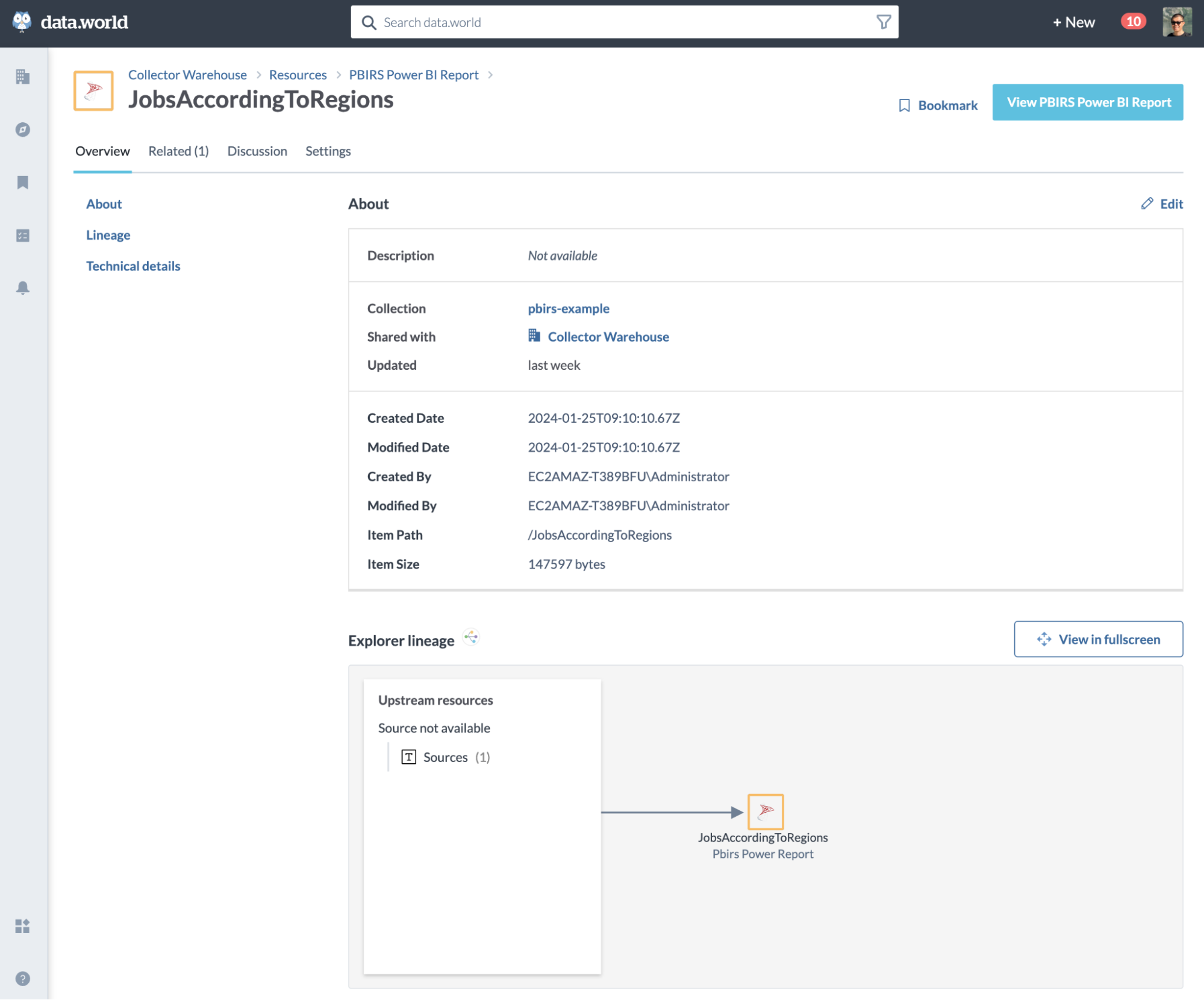About the Power BI Report Server collector
Warning
This collector is in public preview. It has passed our standard testing, but it is not yet widely adopted. You might encounter unforeseen edge cases in your environment. data.world is committed to promptly addressing any issues with public preview collectors. If you face any problems, please report them through your Customer Success Director, implementation team, or support team for assistance.
The Power BI Report Server (PBIRS) collector is designed to provide you with an effective solution for extracting metadata from your PBIRS environment into the data.world catalog. The integration facilitates the automated extraction, organization, and presentation of specific metadata elements from the PBIRS system. It gives valuable insights into your datasets, data sources, folders, KPIs, reports, and linked reports – all within the data catalog in data.world.
With the PBIRS collector, you can:
Learn more about your Power BI reports and data, including who created a report or dataset and when they were last updated, helping you understand and trust your data.
See the lineage of which datasets were used in a report, allowing you a comprehensive view of the data flowing into a report.
Keep track of KPIs from PBIRS and integrate them with business metrics from other source systems, all within one easy-to-use catalog, leading to better data-informed decisions.
An example of metadata from a PBIRS Report, including Lineage:

Note
The latest version of the Collector is 2.307. To view the release notes for this version and all previous versions, please go here.
What is cataloged
The collector catalogs the following information.
Object | Information cataloged |
|---|---|
Report | ID, Name, Description, Creation Time, Modified Time, Created By, Modified By, Path, Type, Hidden, Size, Data Sources, Favorite, Content Type, Policies. |
Linked Report | ID, Name, Description, Creation Time, Modified Time, Created By, Modified By, Path, Type, Hidden, Size, Content Type, Policies. |
Datasource | ID, Name, Description, Creation Time, Modified Time, Created By, Modified By, Path, Type, Hidden, Size, Parent Folder ID, Connection String, Connection String Overridden, Data Source Type, Credential Retrieval, Content Type, Enabled, Original Connection String Expression Based, Policies. Note: if the Name is not defined, then the Power BI Report Server identifier (GUID) for the data source is used as the name. |
Dataset | ID, Name, Description, Creation Time, Modified Time, Created By, Modified By, Path, Type, Hidden, Size, Policies. |
KPI | ID, Name, Description, Creation Time, Modified Time, Created By, Modified By, Path, Type, Hidden, Size, Content Type, Currency, Value Format, Visualization, Content Type, Policies. |
Folder | ID, Name, Description, Creation Time, Modified Time, Created By, Modified By, Path, Type, Hidden, Size, Content Type, Policies. |
Power BI Report | ID, Name, Description, Creation Time, Modified Time, Created By, Modified By, Path, Type, Hidden, Size, Data Sources, Content Type, Policies. |
Excel Workbook | ID, Name, Description, Creation Time, Modified Time, Created By, Modified By, Path, Type, Hidden, Size, Content Type, Policies. |
Relationships between objects
By default, the harvested metadata includes catalog pages for the following resource types. Each catalog page has a relationship to the other related resource types. If the metadata presentation for this data source has been customized with the help of the data.world solutions team, you may see other resource pages and relationships.
Resource page | Relationship |
|---|---|
Report |
|
Linked Report |
|
Dataset |
|
KPI |
|
Datasource |
|
Folder |
|
Lineage for Power BI Report Server
Object | Lineage Available |
|---|---|
Dataset |
|
Datasource |
|
Report |
|
Power BI Report |
|
Authentication supported
The collector supports username and password authentication and NTLM authentication for PBIRS.